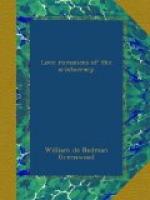“This noble family (Grosvenor) is descended from a long train in the male line of illustrious ancestors, who flourished in Normandy with great dignity and grandeur from the time of its first erection into a sovereign Dukedom, A.D. 912, to the Conquest of England. The patriarch of this ancestral house was an uncle of Rollo, the famous Dane....”
And again:
“The blood of
the great Hugh Lupus, Duke (sic) of
Chester, flows in the
Grosvenor veins.”
This pleasing fiction still rears its head unabashed in spite of all attempts to destroy it; in its honour the late Duke of Westminster was actually named “Hugh Lupus” at the baptismal font, while his younger brother was labelled Richard “de Aquila”; and yet it is an indisputable fact that the Grosvenor ancestors cannot be carried beyond a Robert de Grosvenor, of Budworth, who lived a good century after the Conquest, and who has no more traceable connection with Rollo than with the Man in the Moon.
The Ducal House of Fife, we are told, “derives from Fyfe Macduff, a chief of great wealth and power, who lived about the year 834, and afforded to Kenneth II., King of Scotland, strong aid against his enemies, the Picts.” The present Duke, however, has the good sense to disclaim any hereditary connection with the old Earls of Fife, and to place at the top of his family tree one Adam Duff, who laid the foundation of the family prosperity in the seventeenth century. The Spencers, it is claimed, spring lineally from the old baronial Despencers, “being a branche issueing from the ancient family and chieffe of the Spencers, of which sometymes were the Earles of Winchester and Glocester, and Barons of Glamorgan and Morgannocke.” This, no doubt, is a very distinguished origin; but, alas! the earliest provable ancestors of this “noble” family were respectable and well-to-do Warwickshire graziers, and the first authentic title on the true pedigree is the knighthood conferred on John Spencer in 1519, less than four centuries ago. Similarly the Russells, Dukes of Bedford, are said to be derived from one Hugh de Russell, or Rossel (who took that name from his estate in Normandy), one of the Conqueror’s attendant barons on his invasion of England. Here, again, facts fail lamentably to support the descent claimed, since the earliest known progenitor of this “great house” was that Henry Russell who was sent to Parliament to represent Weymouth in the fifteenth century, and whose great-grandson blossomed into the first Earl of Bedford. (It may, perhaps, be well to state that, although the pedigrees here criticised are those that have been or are widely accepted, they are not necessarily approved by the families whose descent they profess to give.)




